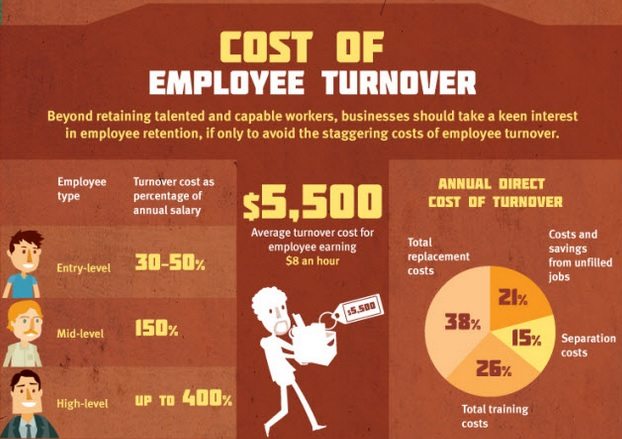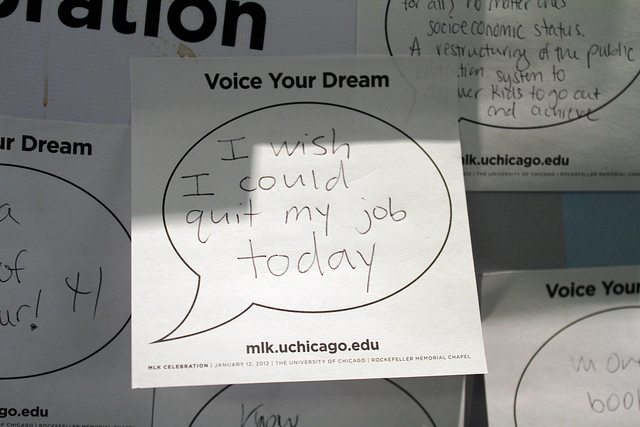Did you know that nearly 1 in 3 new hires leave their jobs within the first year? It doesn’t take a turnover rate formula to know that this is a staggering statistic.
These numbers raise an essential question: what’s driving employees out the door, and what can you do to stop it?
Understanding employee turnover is more than turnover formulas and crunching numbers—it’s uncovering the story those numbers tell about your company.
This article will explore this startling trend, why it’s happening, how to calculate employee turnover rate, and what you can do about it.
What Is Employee Turnover?
Before we get into formulas and how to lower employee turnover, let’s talk about what it is.
Employee turnover is the rate at which employees leave your company and are replaced by new hires. There are two kinds of employee turnover:
- Voluntary turnover occurs when an employee decides to leave for better opportunities, personal goals, or dissatisfaction with their current job.
- Involuntary turnover occurs when employees are laid off or fired from a company, often due to performance problems or organizational restructuring.
Both kinds of employee turnover can significantly impact your company, but understanding how you can reduce turnover rates can help your business thrive.
By using an employee turnover rate formula to gain perspective, and then tackling the issue from within, you can create a more stable and productive workplace with happier employees.
Why is Employee Turnover Such a Big Deal?
People come and go all the time. So, why should you care if someone quits or gets fired? Here’s the thing: employees don’t like being reduced to numbers, and a high employee turnover rate is a drain on company resources.
Think about it: if you’re constantly hiring and training new people, that translates to thousands of lost dollars—especially if they quit a few weeks or months later.
Plus, high turnover rates can be disruptive to your teams and bring down employee morale.
Consequences of High Employee Turnover Rates
Employee turnover is more than a number. It reflects company culture, work environment, and leadership.
High turnover rates indicate problems like:
- Poor management
- Lack of career development opportunities
- General discontent
- A disconnect between employees and employers
Using a turnover rate formula to measure it is simple, but the resulting number highlights the health of your workforce.
Let’s take a closer look at the consequences:
- Financial Loss: Replacing an employee hits your bottom line. Depending on the role, the costs to recruit, hire, and train a replacement can be anywhere from 50% to 200% of an employee’s salary.
- Productivity Loss: When someone leaves, it disrupts the team’s workflow. Onboarding new employees takes time, and other employees have to pick up the slack. This may also lead to burnout and more potential employee losses.
- Morale Impact: A revolving door of employees creates instability and uncertainty in the workplace. The remaining team members may feel disengaged, stressed about losing their jobs, or demotivated by the constant change.
- Reputation Damage: Companies with high employee turnover rates develop a terrible reputation in the job market. Talented candidates may think twice before applying because they wonder why an organization can’t keep its people.
The bottom line is that employee turnover is more than a stat on a spreadsheet. It has real-world business consequences that impact both remaining employees and employers as much as the company itself.
How Do You Calculate Turnover Rate? The Simple Turnover Rate Formula
Now that we’ve established why employee turnover rates are something to pay attention to, let’s discuss how to calculate them. It may be simpler than you think, and the formula will make you feel like a math whiz.
Here’s a step-by-step breakdown:
1. Count Departures
Tally how many people left your company during a given period—consider starting with a quarter. This includes voluntary and involuntary departures.
For example, if someone had been fired in April and then two people quit in May, you would count them as three people within two months.
2. Find the Average Number of Employees
Add the number of employees at the beginning of a period to the number at the end, then divide by two.
For example, if you had 100 employees at the beginning of the period and 90 at the end, your average would be 95 using this formula:
- 100 + 90 = 190
- 190 / 2 = 95
3. Apply the Formula
Divide the number of employees who leave the company by the average number of employees working, then multiply by 100 to get a solid percentage. That is your employee turnover rate.
For instance, if you started the year with 100 employees but then 10 leave, your employee turnover rate would be just over 10% using this formula:
- 10 / 95 = 0.105
- 0.105 x 100 = 10.5
This provides a benchmark for comparison with your competition. You’ll also use it to gauge progress toward lowering your turnover rate over time.
What Is a Healthy Employee Turnover Rate?
This is a million-dollar question, and the answer varies depending on the industry. There’s no universal truth here.
Different companies and roles have different expectations. That said, most businesses aim for an annual turnover of less than 15%.
Tech & Retail Turnover Rates
Technology and retail industries tend to have higher turnover rates (sometimes up to 30%) because of seasonal roles, the mundanity of the jobs, and competitive job markets for advancement opportunities.
When everyone is vying for a manager position, employees can become frustrated and decide to leave to pursue easier ventures.
Healthcare & Education Turnover Rates
Healthcare and education industries see lower turnover rates (typically around 8%) because employees must work on specialized skills, so their work is more stable and less of a spur-of-the-moment choice.
Essentially, these employees are less likely to quit when working hard to secure a rewarding position.
It’s All About Your Industry’s Normal
Healthy employee turnover rates vary, so if you run a tech startup with a turnover rate of 25%, that may be the norm. However, if your business is in healthcare with a 20% turnover rate, that would be a red flag.
Do a bit of research on the normal turnover rates expected in your industry and compare your number against this to determine how your company is faring.
What Contributes To High Employee Turnover?
What does it mean when employee turnover is high? Does high employee turnover automatically equate to bad bosses and horrible work conditions? Not exactly.
There are several contributing factors to a high employee turnover rate:
- Poor Management: The number one reason employees leave their jobs is management. Some leaders are intentional tyrants, while others lack skill. It usually concerns an issue with communication, micromanagement, or support.
- Limited Career Growth: People want to excel, grow, and succeed. Employees who don’t see a path to advancement will seek opportunities elsewhere.
- Inadequate Compensation: Every industry has a standard of pay and benefits. Employees paid below standard will leave for higher-paying jobs with better benefits.
- Toxic work culture: Work isn’t high school, but it can feel overwhelming and chaotic, especially when employees feel undervalued, overworked, and underappreciated. No one wants to feel like a number or a burden.
- Burnout: Overburdening employees with too many tasks or unrealistic expectations leads to burnout. Essentially, turnover rates spike when your employees don’t want to be at work anymore.
High employee turnover isn’t chance—it’s often the result of multiple simultaneous factors that push employees out the door.
Identifying and addressing these issues will help businesses create a more stable workplace.
How To Lower Employee Turnover: 7 Effective Strategies
Did the employee turnover rate formula reveal an issue within your company? Then it’s time for change!
Reducing staff turnover requires attentiveness, awareness, and kindness. These changes don’t have to be drastic, but they must be intentional.
Here are seven proven strategies to keep your company team around for longer.
1. Hire the Right People
Recruitment is the first step to reducing employee turnover. When you hire someone, ensure their core values and expectations align with your company’s workflow and culture.
Do they have the potential to succeed in your industry? Will they get along well with others while helping foster a positive work environment? Do they seem passionate about your core values?
“When core values are done right, they can be a form of inspiration because I think it’s so much easier to rally a team, rally an organization around, ‘man, look at how we’re helping our customers, look at the successes our clients are having’ instead of, ‘look what the company’s doing’,” says career consultant Braxton Wood.
2. Offer Competitive Compensation
Regularly review payroll and benefits packages to ensure employees are well compensated. When someone works hard and helps your company meet new goals, reward them to acknowledge their effort and achievement.
3. Help Employees Succeed
Remember, your employees want to succeed! Help them develop their skills to grow and advance within your company. Invest in training programs and mentorships to help them establish new career-oriented goals that drive them forward.
“We have to try things. We have to be able to take risks. And as a leader, you need to support that. And, and then not throw somebody under the bus if something goes wrong, you know, so we want to be able to support those things and give people opportunities to flourish,” says Wendy Hanson, leadership coach and founder of New Level Work.
4. Create a Positive Company Culture
Your company culture should make your employees feel supported, valued, and included.
Workplace bullying, toxic behavior, or exclusion has no place in the office (or anywhere), so address allegations and negativity with a no-nonsense attitude.
5. Recognize & Reward Success
Acknowledge employee contributions and hard work through appropriate gratitude and rewards.
For example, if someone regularly goes above and beyond, a pay raise and formal award may be in order. Even a simple “thank you” and smile after task completion helps boost employee morale. Additionally, peer recognition is just as important:
“Peer recognition is often kind of bucketed as this nice to have, oh, just make sure to tell people thank you. But there’s so much more to it and there’s a recipe to do it correctly.
“There’s a way to give meaningful recognition that needs to be trained to employees. It’s a really powerful way to drive engagement across teams, not just top down, but management down,” says Christie Hoffman, people and management expert.
6. Foster Better Leadership Skills
Managers should be supportive, transparent, friendly, and approachable. Those who excel in leadership roles can significantly improve employee retention because people want to be around them.
“If you have a team, you thrive when you’re getting the best from everyone. Everybody has to feel empowered to be their true version of themselves. If they don’t feel valued for who they are, then you won’t get their best,” says TEDx inclusion activist Ash Beckham.
7. Conduct Exit Interview
When employees leave, ask for feedback! Use exit interviews to gather data on how you can improve your company. Ask productive questions, avoid accusatory or guilt-trippy tones, and show genuine interest in responses.
When Should You Seek Professional Help to Reduce Turnover Rates?
Is high staff turnover becoming a persistent problem, regardless of how you implement resolution strategies? Were your results from the turnover rate formula alarming?
It’s time to seek outside help.
HR consultants or employee engagement experts can oversee your company’s interactions and operations. They’ll also help you customize strategies to get employee retention back on track.
Sometimes, a fresh perspective is all you need to regain your footing. Consider seeking professional assistance if:
- Your employee turnover rate is significantly higher than other companies in your industry.
- Different employees cite the same reasons for leaving, showing problematic patterns in the workplace.
- Your leadership team is stretched thin, burnt out, and at a loss. They need expert support to help address employee turnover.
Remember, it’s not helpful to wait for high turnover to erode your team’s morale and disrupt your company’s productivity and reputation.
Bringing in outside expertise is a workforce investment for long-term success. Your employees are your most valuable asset, so ensure their satisfaction to make employee retention an achievable, sustainable goal.
Reducing Employee Turnover for Long-Term Success
Some employee turnover is inevitable. If you’re using the turnover rate formula regularly, your numbers will fluctuate, and that’s normal!
Sometimes, people leave for no other reason than to seek something new or because something changed in their lives.
However, consistently high employee turnover rates can quickly become a problem that reflects poorly on your company.
The goal is to reduce turnover while creating an environment where employees want to stay. Addressing root causes and implementing the right strategies can build an engaged, loyal workforce with turnover rates in standard (or below-average) ranges.
Focus On Employee Retention
As a business owner, you have multiple responsibilities, which can lead to chaos when running a company.
However, shifting your focus to purposeful employee retention can help you build stronger teams while enhancing productivity, fortifying a positive company reputation, and cutting costs associated with employee turnover.
If you strive to create a workplace where employees thrive, your business will reach its full potential.
How Team Building Fixes Employee Turnover
Team building may seem cliché, like something from a corporate retreat (think trust falls and awkward icebreakers), but when done correctly, team building could be the secret to getting employees to stick around.
When people feel connected, they’re less likely to bail at the first sign of trouble.
Camaraderie turns colleagues into friends, creating a support system that makes Monday morning more bearable, and work challenges become a team effort rather than solo battles. People are more likely to stay where they feel they belong.
Let’s be honest: who doesn’t want a work buddy to share memes with during lunch breaks?
Drive Real, Measurable Results
Team building drives actual, measurable results, and not just the ones you’ll see using the turnover rate formula.
Engaged teams communicate better, collaborate more effectively, and tackle workplace problems with less finger-pointing and panic. This translates to higher productivity and fewer headaches for everyone.
Of course, employees who feel valued by their peers and included in team building endeavors are also less likely to job-hop. And this saves your company from recruitment and training costs.
Ultimately, investing in team building makes people happier because you’re creating a workplace where employees want to stay. It’s just that simple.
Beat Employee Turnover with TeamBonding
High employee turnover rates don’t have to be your company’s recurring plot twist.
At TeamBonding, we specialize in making workplaces feel like communities, where employees stick around because they want to be there (not because they have to be).
Our activities and retention strategies have proven successful. We can help you create a company environment where talent thrives, collaboration is welcome, and turnover becomes yesterday’s problem.
Employee turnover can rob you of your best employees and peace of mind, so take a look at the 200+ programs in our catalog to find something that’ll address the issues you’re facing.
Ready to get started? Contact TeamBonding to discover how to build a better workplace that is as magnetic as your goals are ambitious. Team up to keep your team together!

















